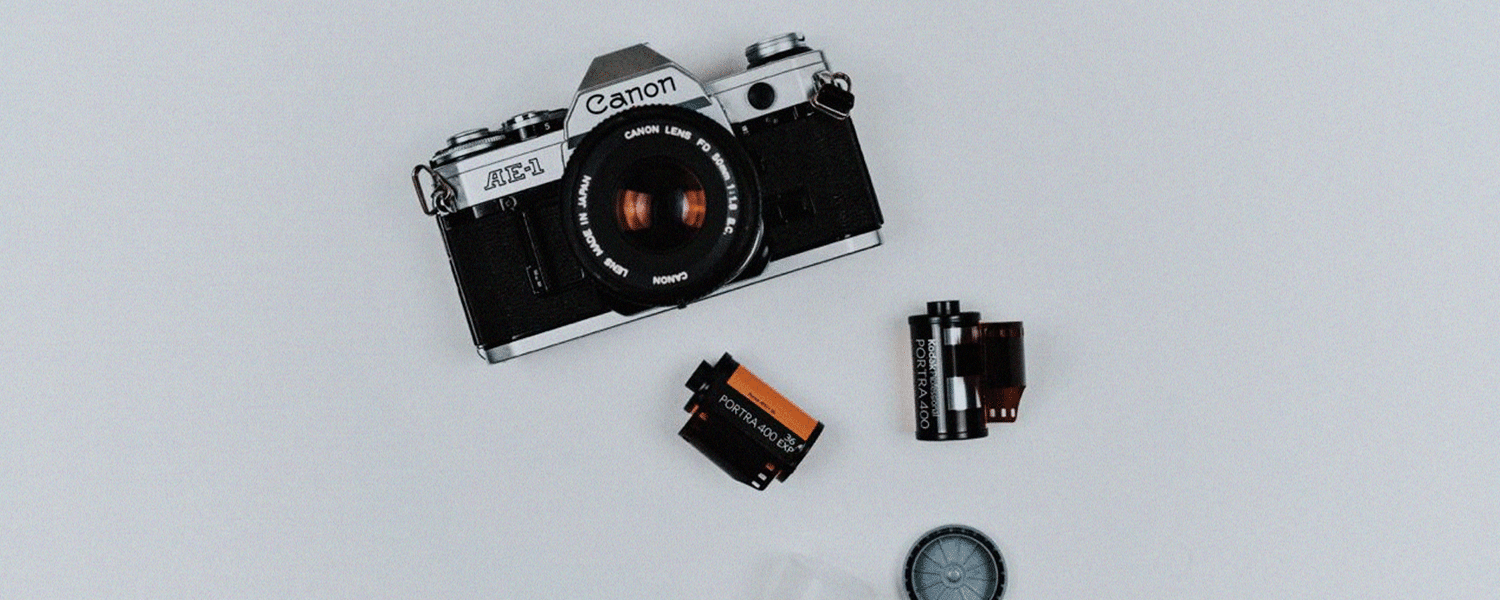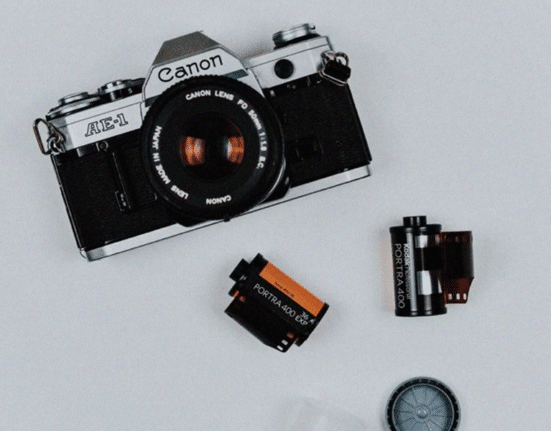Senior photojournalist Ron Asuncion, 28, first fell in love with vintage items in 2014.
Gramophones, old records, and old phones are what made him drawn to this vintage craze that has been popular among the young generation.
One of his coworkers at the BPO company where he was working at the time introduced him to an expo in Cubao, Quezon City, where old cameras were sold. However, he wasn’t able to attend.

Asuncion wasn’t particularly interested in cameras at first, but his curiosity about the vintage trend eventually shifted his attention to film cameras.
Coincidentally, a college friend who has been into film photography offered Asuncion his rangefinder camera, which he then bought.
That was the beginning of his film photography journey and his support for the revival of the film camera industry.
Building film community
Helping people is the reason why Asuncion continues to do film photography.
When he began this journey, he made a mini-project for himself where he would help a home for the elderly in Quezon City by donating the funds he earned from selling prints to his colleagues in BPO.
“Sobrang sarap niya sa feeling kasi bukod sa nagagawa mo ‘yung gusto mo that time, obsession ko that time, nakatulong ako,” Asuncion told republicasia.
This initiative motivated him to do more for his community, leading him to build The Film Cartel.

The Film Cartel was originally a film camera shop, but Asuncion decided to turn this into a community that helps other film camera shops promote their businesses and individuals who are taking an interest in film photography.
Asuncion helps other shops by reposting their products every “Sale Friday” to reach more potential buyers. He also travels to different places in the country to conduct workshops for beginners and enthusiasts of film photography.
Another film camera shop is also part of the drive to support the film community.
Twenty-three-year-old UP student Lester Rimorin established Buti Pa Yung Film Nadevelop (BPYFND) in 2019 to help enthusiasts source affordable yet quality film cameras.
“[K]asi noon pahirapan pa like nasa Metro Manila lang ‘yung sikat na nagbebenta ng mga film, so why not ipakalap natin nationwide kasi ‘di ba uso na ‘yung shipping? Para hindi na mahirapan ‘yung mga nasa provinces,” he told republicasia, adding that most of his customers are from provinces.
Some enthusiasts also send him messages through BPYFND’s page to seek advice on their film cameras, to which Rimorin gladly responds.

Twenty-four-year-old student Steph Ramirez also brings the film community closer to people through The Film Guild, an online shop she opened in 2021. Film enthusiasts can choose from a variety of film cameras in the shop that Ramirez carefully picked and sourced overseas.
Interest in film
Despite the digital age, where most cameras can produce output in an instant, many young people are still interested in film cameras like Asuncion, Rimorin, and Ramirez.
Rimorin believes that there are various reasons why today’s generation is invested in this type of camera.
He said he personally prefers film cameras because they capture nostalgic vibes in their raw outputs. It is also fulfilling for him to produce photos using this camera.
Unlike digital cameras, it will take time for a person to see the output of a film camera.
The process starts with sourcing film rolls, which have different numbers of exposures; 12 and 24, but the most common nowadays is 36. With limited frames, the user will have to plan out scenarios they need to capture to maximize the film roll.
After that, the roll will be taken to a photo shop to be developed into photographs. Transferring the negative onto photo paper usually takes a few days. In Rimorin’s experience, the longest period he had to wait for was two to three weeks.
“Simula doon sa pagso-source ng film hanggang sa makuha mo ‘yung picture, months talaga [inaabot]. Ayon ‘yung difference niya sa digital photography, process talaga,” he said.
Ramirez, meanwhile, noticed that many young people turned to film cameras because of their aesthetics.
Like Rimorin, she also finds film cameras more exciting because of their “elements of surprise, unpredictability, and creativity” that she can only see once she receives the outputs.
“Perhaps, we are all motivated by the same feelings: nostalgia and longing for the past; the enchantment and intentionality of film; and the influence of the saying, ‘You only have one shot,’” she said.
Lamberto Fuentes, 82, started repairing film cameras in Hidalgo, Quiapo, the “Photographers’ Haven,” in 1960.

In his 63 years as a film camera technician, Fuentes said it was gratifying to see that film cameras are still being used today, specifically by youth.
“At least nagagamit pa rin nila ‘yung mga ginagawa namin nung araw. At least nabubuhay ‘yung ganun. Hindi totally talaga na mawawala yan. Kahit na sabihin mo ‘yung digital na ano ngayon… Kasi ‘yang digital na yan sigurado ko yan, ‘di naman magtatagal ang mga ano nyan [parts], [hindi] katulad sa film,” he said.
Film camera technician Dems Alicos, 64, also believes that film cameras will thrive even with the emergence of high-tech cameras.

He shared that a lot of students come to their shop every day to ask about film cameras and film photography. Alicos, who is also a photographer, said they would seek his recommendation for film cameras and sometimes the process of film photography.
“Sa film cameras kasi, ang most interesting part doon is ‘yung knowledge na ibinibigay niya. Halimbawa, kung paano iprocess ‘yung film, paano i-convert into picture sa photo paper na,” he said, describing this process as highly sophisticated.
“From film, ide-develop ‘yan into negative. From negative ide-develop ulit ‘yun into positive na para maging image sa photo paper. So ‘yun siguro ang interesting part na maituro natin sa bata para maging interesado sila sa film photography ulit,” he said.
Why revive film cameras?
Film camera enthusiast Asuncion, film camera shop owners Rimorin and Ramirez, and film camera technicians Fuentes and Alicos all want one thing: for film cameras to continue flourishing.
Some film camera enthusiasts temporarily switched to digital due to the high price of film rolls. While there are still rolls that cost P200, many of these are sold for more than P600.
However, Rimorin and Asuncion hope that the prices will eventually become cheaper.
“Sana eventually um-okay na, bumaba na ulit ‘yung presyo para bumalik ‘yung mga tao sa film cameras kasi kailangang buhayin ‘yung film community, ‘yung film industry kasi bukod sa mga aesthetic looks, para na kasi siyang culture natin,” Rimorin stressed.
He added that if film cameras vanished, the next generation would not know about this way to produce photos.
“Kasi malaking effect din kung makakalimutan natin lahat ng mga type of arts kasi ngayon more on digital na tayo,” he said.
He went on, saying, “Gusto namin na buhayin talaga, na sa future generation, kilala pa rin at magagamit.”
With the continued projects and pure intentions of the film community, he believes that film cameras will be sustainable and thrive in the future.

In partnership with other communities, Asuncion is trying to achieve film sustainability in the Philippines by reloading film rolls in old canisters.
With film cameras, the senior photojournalist said that aspiring photographers will learn more about the fundamentals.
“‘Pag gusto mong maging photographer nowadays, bibili ka ng digital camera, so kakalikutin mo ‘yung modes, ‘yun na,” he said.
“[P]arang hindi mo na alam ‘yung correlations nung mga fundamentals sa photography. Hindi mo alam ‘yung ISO, hindi mo alam ‘yung shutter speed, ‘di mo alam yung aperture. Lahat yon, ayun ‘yung una mong ita-tackle with film photography in general,” he continued.
Fuentes agreed with this as he encouraged the youth to try using film cameras.
“Unang una, nakaka-challenge yan eh. Alam mo kung bakit? Magagamit mo utak mo kung paano mo gagamitin ‘yung camera,” he said.
Tips before trying film cameras
For those pondering what type of film camera they should buy, Rimorin and Ramirez said customers should know what suits their preference.
For beginners, both of them recommended a point-and-shoot camera as it is simple to use and lighter to carry.
“As a beginner, ang sinasabi ko lahat i-try eh. Parang kung anong meron ka, accessible. May iba kasing customer nakukuha nila film camera nila dahil sa parents eh, sa mga lolo’t lola,” Rimorin said.
“Kung wala ka talagang film camera, [advice] ko talaga point-and-shoot. Itong mga point-and-shoot na ‘to, hindi ka na mahihirapan mag-set ng mga setting kasi automatic na siya,” he explained.

Ramirez also suggested using SLRs or rangefinders if they want a “more technical approach.”
But these are only their recommendations. She and Rimorin still advise their customers to do more research on whatever camera they want to use.
“Different cameras may be more suitable for various users in various circumstances! Remember that there is no ‘correct’ way to take a photograph on film; it is merely a tool for artistic exploration,” Ramirez said.









